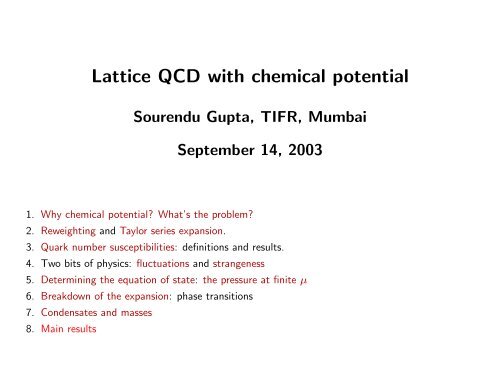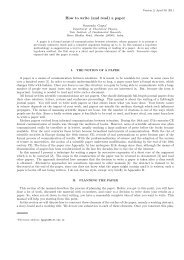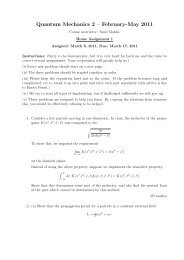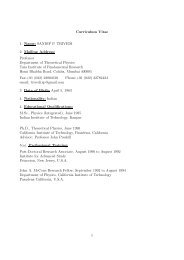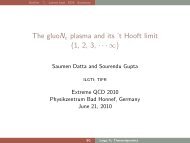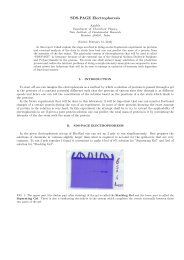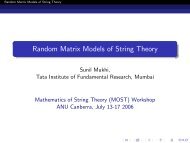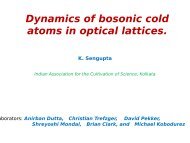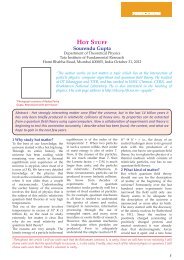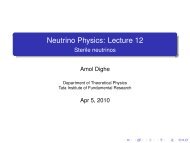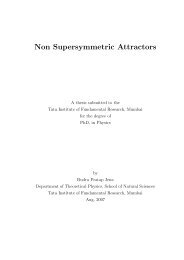Lattice QCD with chemical potential
Lattice QCD with chemical potential
Lattice QCD with chemical potential
Create successful ePaper yourself
Turn your PDF publications into a flip-book with our unique Google optimized e-Paper software.
<strong>Lattice</strong> <strong>QCD</strong> <strong>with</strong> <strong>chemical</strong> <strong>potential</strong><br />
Sourendu Gupta, TIFR, Mumbai<br />
September 14, 2003<br />
1. Why <strong>chemical</strong> <strong>potential</strong>? What’s the problem?<br />
2. Reweighting and Taylor series expansion.<br />
3. Quark number susceptibilities: definitions and results.<br />
4. Two bits of physics: fluctuations and strangeness<br />
5. Determining the equation of state: the pressure at finite µ<br />
6. Breakdown of the expansion: phase transitions<br />
7. Condensates and masses<br />
8. Main results
Why <strong>chemical</strong> <strong>potential</strong>?<br />
T<br />
RHIC<br />
QGP<br />
= color<br />
superconducting<br />
crystal?<br />
gas<br />
liq<br />
CFL<br />
nuclear<br />
compact star<br />
µ<br />
Flavour symmetry: one µ for every independent conserved charge.<br />
M. G. Alford, K. Rajagopal, F. Wilczek, Phys. Lett., B 422 (1998) 247,<br />
R. Rapp, T. Schafer, E. V. Shuryak, M. Velkovsky, Phys. Rev. Lett., 81 (1998) 53.<br />
Chemical <strong>potential</strong>/S. Gupta: IMSc, 2003 to plan, Phases, Reweight, Expansion, QNS, strangeness, EOS, masses, end 2
What’s the problem?<br />
Z = e −F/T = ∫ DUe −S ∏ f det M(U, m f, µ f ) = ∫ DUe −S(T,µ)<br />
Dirac operator: M = m + i∂ µ γ µ<br />
• If there is a Q such that M † = Q † MQ, then clearly det M is real.<br />
• Q = γ 5 for µ = 0. Nothing for µ ≠ 0.<br />
• Monte Carlo simulations of Z fail.<br />
• Under CP symmetry {U} → {U ′ } such that det M(U) = [det M(U ′ )] ∗ .<br />
• Z remains real and non-negative— thermodynamics is safe.<br />
Chemical <strong>potential</strong>/S. Gupta: IMSc, 2003 to plan, Phases, Reweight, Expansion, QNS, strangeness, EOS, masses, end 3
Reweighting: what it is<br />
Do simulations at µ f = 0, re-express expectation values in terms of these—<br />
β<br />
Budapest method<br />
〈O〉 µ<br />
=<br />
〈O exp(−∆S)〉<br />
〈exp(−∆S)〉<br />
where<br />
S = S − ∑ f<br />
Tr log M f ,<br />
Glasgow method<br />
µ<br />
Reweighting done for coarse lattices (N t = 4) and N f = 4, 2 and 2+1.<br />
Chemical <strong>potential</strong>/S. Gupta: IMSc, 2003 to plan, Phases, Reweight, Expansion, QNS, strangeness, EOS, masses, end 4
Reweighting and other direct approaches<br />
• Two parameter reweighting and results.<br />
Z. Fodor and S. D. Katz, J. H. E. P., 03 (2002) 014.<br />
• Express the reweighting in terms of derivatives of Z <strong>with</strong> respect to µ.<br />
C. R. Allton et al., Phys. Rev., D 66 (2002) 074507<br />
• Simulate imaginary µ (positive det M) and do analytic continuation.<br />
M. D’Elia and M.-P. Lombardo, hep-lat/0209146<br />
P. De Forcrand and O. Philipsen, Nucl. Phys., B642 (2002) 290<br />
• Special care needed for this: find Yang-Lee zeroes directly.<br />
S, Gupta, hep-lat/0307007.<br />
• Canonical partition functions and propagator matrix.<br />
P. Crompton, P. Higgs, MILC, BI, etc<br />
Chemical <strong>potential</strong>/S. Gupta: IMSc, 2003 to plan, Phases, Reweight, Expansion, QNS, strangeness, EOS, masses, end 5
Chemical <strong>potential</strong>/S. Gupta: IMSc, 2003 to plan, Phases, Reweight, Expansion, QNS, strangeness, EOS, masses, end 6
Reweighting: lattice artifacts<br />
Chemical <strong>potential</strong> on the lattice is prescription dependent. Why? The continuum<br />
Dirac operator specifies effects of an infinitesimal time translation. On the lattice<br />
we deal <strong>with</strong> finite translations (by lattice spacing a). There are many ways of<br />
doing this which lead to the same infinitesimal transformation.<br />
This is the origin of problems <strong>with</strong> reweighting: it gives no indication of how large<br />
the lattice artifacts are.<br />
Taylor series expansion is prescription dependent beyond 2nd order at every finite<br />
lattice spacing a, but prescription independent for a → 0. With explicit Taylor<br />
expansion we can take the continuum limit.<br />
R. V. Gavai and S. Gupta, Phys. Rev. D 68 (2003) 034506.<br />
Chemical <strong>potential</strong>/S. Gupta: IMSc, 2003 to plan, Phases, Reweight, Expansion, QNS, strangeness, EOS, masses, end 7
The Taylor Expansion<br />
Since P V = −F = T log Z, the Taylor expansion of P is the same as of F !<br />
1<br />
V P (T, µ u, µ d ) = 1 V P (T, 0, 0) + ∑ f<br />
n f µ f + 1 2!<br />
where the quark number densities and susceptibilities are—<br />
∑<br />
χ fg µ f µ g + · · ·<br />
fg<br />
n f = T V<br />
χ fg = T V<br />
χ fgh··· = T V<br />
∂ log Z<br />
∂µ f<br />
∣ ∣∣∣µf<br />
=0<br />
∣<br />
∂ 2 log Z ∣∣∣µf<br />
∂µ f ∂µ g =µ g =0<br />
∂ n log Z<br />
∣<br />
∂µ f ∂µ g ∂µ h · · ·<br />
∣<br />
µf =µ g =···=0<br />
Chemical <strong>potential</strong>/S. Gupta: IMSc, 2003 to plan, Phases, Reweight, Expansion, QNS, strangeness, EOS, masses, end 8
Derivatives<br />
Derivatives of log Z can be expressed in terms of derivatives of Z. The latter can<br />
be constructed by the chain rule.<br />
Z f = ∂Z<br />
∂µ f<br />
=<br />
∫<br />
DUe −S Tr M −1<br />
f M ′ f.<br />
Note: M ′ = γ 0 and M −1 = ψψ, so Tr M −1 M ′ = ψ † ψ. Odd derivatives vanish<br />
for µ f = 0 by CP symmetry. S. Gottlieb et al., Phys. Rev. Lett., 59 (1987) 2247<br />
1 2 11<br />
111 21 3<br />
S. Gupta, Acta Phys. Pol., B 33 (2002) 4259<br />
Chemical <strong>potential</strong>/S. Gupta: IMSc, 2003 to plan, Phases, Reweight, Expansion, QNS, strangeness, EOS, masses, end 9
Quark number susceptibilities: phenomena<br />
• Fluctuations of conserved quantities in heavy-ion collisions are related to χ uu .<br />
Isospin fluctuations are related to χ 3 = χ uu − χ ud , charge fluctuations can also<br />
be constructed out of these. M. Asakawa et al., Phys. Rev. Lett., 85 (2000) 2072; S.<br />
Jeon and V. Koch, ibid., 85 (2000) 2076<br />
• Under certain conditions strangeness production rate can be related to the<br />
strange susceptibility, χ ss . R. V. Gavai et al., Phys. Rev., D 65 (2002) 054506<br />
• The pressure at finite <strong>chemical</strong> <strong>potential</strong> is essentially determined by the<br />
susceptibility. R. V. Gavai and S. Gupta, Phys. Rev. D 68 (2003) 034506.<br />
• χ 3 is the zero momentum Euclidean finite temperature vector propagator and<br />
hence closely related to a transport coefficient— the DC electrical conductivity<br />
of quark matter. S. Gupta, hep-lat/0301006.<br />
Chemical <strong>potential</strong>/S. Gupta: IMSc, 2003 to plan, Phases, Reweight, Expansion, QNS, strangeness, EOS, masses, end 10
Some notation<br />
With two degenerate flavours of quarks, in flavour space the linear susceptibilities<br />
form the matrix (<br />
χuu χ ud<br />
χ ud χ uu<br />
)<br />
Transforming to µ 0 = µ u + µ d and µ 3 = µ u − µ d , this matrix becomes<br />
(<br />
χuu + χ ud 0<br />
0 χ uu − χ ud<br />
)<br />
χ 3 = χ uu − χ ud = 〈 Tr M −1 M ′ M −1 M ′ − Tr M −1 M ′′〉<br />
χ ud =<br />
〈 (Tr<br />
M −1 M ′) 2 〉 and χ 0 = χ 3 + 2χ ud<br />
Chemical <strong>potential</strong>/S. Gupta: IMSc, 2003 to plan, Phases, Reweight, Expansion, QNS, strangeness, EOS, masses, end 11
Finding the continuum limit<br />
Main technical problem is to control the extrapolation to zero lattice spacing. For<br />
this we use two different kinds of Fermions (staggered and Naik) and perform<br />
simultaneous extrapolation <strong>with</strong> both: in the quenched theory.<br />
R. V. Gavai and S. Gupta, Phys. Rev. D 67 (2003) 034501<br />
1.8<br />
1.6<br />
/T 2<br />
χ 3<br />
1.4<br />
1.2<br />
1<br />
0.8<br />
0 0.01 0.02 0.03 0.04 0.05 0.06 0.07<br />
1/N<br />
2<br />
t<br />
Chemical <strong>potential</strong>/S. Gupta: IMSc, 2003 to plan, Phases, Reweight, Expansion, QNS, strangeness, EOS, masses, end 12
Perturbation theory<br />
1.0<br />
1<br />
0.9<br />
NL<br />
HTL<br />
0.95<br />
χ /Τ 2<br />
3<br />
0.8<br />
0.7<br />
χ uu<br />
/T 2<br />
0.9<br />
0.85<br />
∆ = 2<br />
∆ = 1<br />
∆ = 0<br />
∆ = −1<br />
∆ = −2<br />
<strong>Lattice</strong><br />
0.6<br />
1 2 3<br />
T/T c<br />
0.8<br />
1 2 3 4 5<br />
T/T c<br />
J.P. Blaizot, E. Iancu and A. Rebhan, Phys. Lett., B 523 (2001) 143<br />
A. Vuorinen, hep-ph/0212283<br />
Chemical <strong>potential</strong>/S. Gupta: IMSc, 2003 to plan, Phases, Reweight, Expansion, QNS, strangeness, EOS, masses, end 13
χ ud and χ uu<br />
1.0<br />
1<br />
χ 3 /T 2<br />
0.8<br />
0.6<br />
0.4<br />
0.2<br />
10 5 χ ud /T 2<br />
0.5<br />
0<br />
-0.5<br />
-1<br />
-1.5<br />
0<br />
0.5 1 1.5 2 2.5 3<br />
T/Tc<br />
-2<br />
0.5 1 1.5 2 2.5 3<br />
T/Tc<br />
(Note the difference in scales!)<br />
Chemical <strong>potential</strong>/S. Gupta: IMSc, 2003 to plan, Phases, Reweight, Expansion, QNS, strangeness, EOS, masses, end 14
Event to event fluctuations<br />
Each heavy-ion collision event, followed by the hadronisation, is one realisation of<br />
the whole ensemble of possible thermodynamic systems. Within a given rapidity<br />
region, the total amount of any conserved charge fluctuates from one event to<br />
another. The variance is determined by the response function of <strong>QCD</strong> matter in<br />
equilibrium.<br />
M. Asakawa et al., Phys. Rev. Lett., 85 (2000) 2072<br />
S. Jeon et al., Phys. Rev. Lett., 85 (2000) 2076<br />
D. Bower and S. Gavin, Phys. Rev., C 64 (2001) 051902<br />
From lattice computations it is seen that<br />
χ B < χ Q < χ s (T > T c )<br />
χ B > χ Q > χ s (T < T c )<br />
R. V. Gavai, S. Gupta, P. Majumdar, Phys. Rev., D 65 (2002) 054506<br />
Chemical <strong>potential</strong>/S. Gupta: IMSc, 2003 to plan, Phases, Reweight, Expansion, QNS, strangeness, EOS, masses, end 15
Strangeness production<br />
[ ]<br />
Dynamical <strong>QCD</strong> (T c )<br />
Quenched <strong>QCD</strong> (T c )<br />
RHIC Au-Au<br />
SpS S-S<br />
SpS S-Ag<br />
SpS Pb-Pb<br />
AGS Au-Au<br />
AGS Si-Au<br />
0.2 0.4 0.6 0.8 1<br />
λs<br />
J. Cleymans, J. Phys., G 28 (2002) 1575,<br />
λ s = 〈n s〉<br />
〈n u + n d 〉<br />
R. V. Gavai and S. Gupta, Phys. Rev., D 65 (2002) 094515.<br />
Chemical <strong>potential</strong>/S. Gupta: IMSc, 2003 to plan, Phases, Reweight, Expansion, QNS, strangeness, EOS, masses, end 16
The pressure<br />
P (T, µ) = −F/V = P (T, 0) + χ 3 (T )µ 2 + 1 12 χ uuuu(T )µ 4 + O ( µ 6)<br />
= P (T, 0) +<br />
(<br />
µ<br />
µ (2)<br />
∗<br />
) 2<br />
⎡<br />
⎣1 +<br />
(<br />
µ<br />
µ (4)<br />
∗<br />
) 2<br />
⎧<br />
⎨<br />
⎩ 1 + (<br />
µ<br />
µ (6)<br />
∗<br />
) ⎤<br />
2<br />
⎬<br />
+ · · ·⎫<br />
⎦ .<br />
⎭<br />
where µ (2)<br />
∗ = √ 2/χ uu , µ (4)<br />
∗ = √ 12χ uu /χ uuuu , µ (6)<br />
∗<br />
= √ 30χ uuuu /χ uuuuuu , etc.<br />
Well-behaved for µ ≪ µ ∗ . All results can be obtained in the continuum. Term by<br />
term improvement of the series is possible.<br />
Chemical <strong>potential</strong>/S. Gupta: IMSc, 2003 to plan, Phases, Reweight, Expansion, QNS, strangeness, EOS, masses, end 17
The equation of state<br />
0.5<br />
100<br />
0.4<br />
1.03<br />
10<br />
1<br />
∆P/T 4<br />
0.3<br />
0.2<br />
0.73<br />
∆ P/T 4<br />
0.1<br />
0.01<br />
1 dP<br />
T dn<br />
0.1<br />
0.44<br />
0.001<br />
0.0001<br />
0<br />
1<br />
0.15<br />
1.5 2 2.5 3<br />
T/T c<br />
0.001 0.01 0.1 1 10<br />
n/T3<br />
∆P (T ) = P (T, µ) − P (T, 0)<br />
R. V. Gavai and S. Gupta, Phys. Rev. D 68 (2003) 034506.<br />
See also<br />
Z. Fodor, S. D. Katz and K. K. Szabo, hep-lat/0208078,<br />
C. R. Allton et al., Phys. Rev., D 68 (2003) 014507.<br />
Chemical <strong>potential</strong>/S. Gupta: IMSc, 2003 to plan, Phases, Reweight, Expansion, QNS, strangeness, EOS, masses, end 18
Radius of convergence: distance to phase transitions<br />
The series expansion breaks down when a phase transition line is encountered. Use<br />
any estimate of the radius of convergence to obtain an estimate of the position of<br />
the phase transition line.<br />
4<br />
3<br />
/T<br />
*<br />
µ n<br />
2<br />
1<br />
0.95Tc<br />
2Tc<br />
0<br />
0 2 4 6 8 10<br />
n<br />
Qualitative difference between T < T c and T > T c ?<br />
Chemical <strong>potential</strong>/S. Gupta: IMSc, 2003 to plan, Phases, Reweight, Expansion, QNS, strangeness, EOS, masses, end 19
Condensates and masses<br />
Taylor expansions can also be made for expectation values of any operator. We<br />
are investigating this for<br />
1. Condensates: 〈ψψ〉 changes quadratically <strong>with</strong> µ, and the quadratic coefficient<br />
is the same for isovector and baryon <strong>chemical</strong> <strong>potential</strong>. This number is also<br />
related to λ s in strangeness production through a Maxwell relation.<br />
2. Masses: The mass splitting of charged pions at finite isovector <strong>chemical</strong><br />
<strong>potential</strong> is linear in µ, but that of the neutral pion is quadratic. This quadratic<br />
coefficient is the same as shift in pion mass at finite baryon <strong>chemical</strong> <strong>potential</strong>.<br />
O. Miyamura et al., Phys. Rev., D 66 (2002) 077502,<br />
S. Gupta, hep-lat/0202005, S. Gupta and Rajarshi Ray, in progress<br />
Chemical <strong>potential</strong>/S. Gupta: IMSc, 2003 to plan, Phases, Reweight, Expansion, QNS, strangeness, EOS, masses, end 20
Summary of Results<br />
More than one method for computing physics at finite µ. One method (Taylor<br />
series expansion) is a precision technique, allowing contact <strong>with</strong> experiments.<br />
• Computation of several high order susceptibilities may allow estimation of the<br />
critical end point by series extrapolation methods.<br />
• Fluctuations and strangeness production rate in heavy-ion collisions are related<br />
to susceptibilities.<br />
• Susceptibilities allow extension of the equation of state to finite <strong>chemical</strong><br />
<strong>potential</strong>.<br />
• Taylor expansions yield identities between behaviour of various quantities at<br />
finite isovector and baryon <strong>chemical</strong> <strong>potential</strong>.<br />
Chemical <strong>potential</strong>/S. Gupta: IMSc, 2003 to plan, Phases, Reweight, Expansion, QNS, strangeness, EOS, masses, end 21


